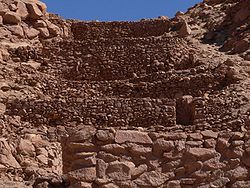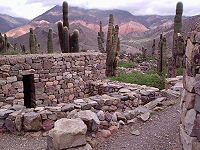
Pucará
Encyclopedia


Fortification
Fortifications are military constructions and buildings designed for defence in warfare and military bases. Humans have constructed defensive works for many thousands of years, in a variety of increasingly complex designs...
s made by the natives of the central Andean culture
Andean culture
Andean culture is a collective term used to refer to the indigenous cultures of the Andes mountains especially those that came under the influence of the Inca empire...
s (that is to say: from Ecuador
Ecuador
Ecuador , officially the Republic of Ecuador is a representative democratic republic in South America, bordered by Colombia on the north, Peru on the east and south, and by the Pacific Ocean to the west. It is one of only two countries in South America, along with Chile, that do not have a border...
to the Central Valley
Zona Central, Chile
Zona central is one of the five natural regions into which CORFO divided continental Chile in 1950. It is home to a majority of the Chilean population and includes the three largest metropolitan areas- Santiago, Valparaíso, and Concepción...
of Chile
Chile
Chile ,officially the Republic of Chile , is a country in South America occupying a long, narrow coastal strip between the Andes mountains to the east and the Pacific Ocean to the west. It borders Peru to the north, Bolivia to the northeast, Argentina to the east, and the Drake Passage in the far...
and the Argentine Northwest
Argentine Northwest
The Argentine Northwest is a region of Argentina composed by the provinces of Catamarca, Jujuy, Salta, Santiago del Estero and Tucumán.-Geography:The region had 5 different biomes:* Sub-Andean humid Sierras of the east...
) and particularly to those of the Inca. The Spanish also referred to Mapuche
Mapuche
The Mapuche are a group of indigenous inhabitants of south-central Chile and southwestern Argentina. They constitute a wide-ranging ethnicity composed of various groups who shared a common social, religious and economic structure, as well as a common linguistic heritage. Their influence extended...
earthen forts in the Arauco War
Arauco War
The Arauco War was a conflict between colonial Spaniards and the Mapuche people in what is now the Araucanía and Biobío regions of modern Chile...
by this term.
Furthermore, one of the most refined branches of the Chavín culture
Chavín culture
The Chavín were a civilization that developed in the northern Andean highlands of Peru from 900 BC to 200 BC. They extended their influence to other civilizations along the coast. The Chavín were located in the Mosna Valley where the Mosna and Huachecsa rivers merge...
is sometimes referred as "Pucará culture" or "Pucará style". It seems to have been a foundation of the later Wari Empire
Wari Empire
The Wari Empire was a political formation that emerged around AD 600 in the central highlands of Peru and lasted for about 500 years, to 1100 AD. It operated about the same time as the Tiwanaku culture and at one time was thought to have been derived from it. In 2008 archeologists found a...
and Tiwanaku
Tiwanaku
Tiwanaku, is an important Pre-Columbian archaeological site in western Bolivia, South America. Tiwanaku is recognized by Andean scholars as one of the most important precursors to the Inca Empire, flourishing as the ritual and administrative capital of a major state power for approximately five...
culture. For the language, see Pukara language.
As a toponym
Today, the term is commonly found in toponyms of the AndesAndes
The Andes is the world's longest continental mountain range. It is a continual range of highlands along the western coast of South America. This range is about long, about to wide , and of an average height of about .Along its length, the Andes is split into several ranges, which are separated...
region, for example:
- Pucará de AndalicánAndalicánAndalicán during the era of conquest and colonial times in Chile was the name of the high hill in the middle of two ravines and site of a fortress built by the Mapuche in 1557 to prevent García Hurtado de Mendoza from invading Araucanía north of Marihueñu and the valley of Colcura...
- Pucará de Angol
- Pucará de CamiñaCamiñaCamiña is a Chilean commune and village in El Tamarugal Province, Tarapacá Region. According to the 2002 census, the commune population was 1,275 and has an area of .-Demographics:...
- Pucará de Cañete
- Pucará de Chena
- Pucará de Nama
- Pucará de QuiapoQuiapo, ChileQuiapo is a place in Arauco Province of Chile that is 25 kilometers to the Southwest of Arauco and about 25 kilometers to the north and east of the port of Lebu to the east of the Bahia del Carnero and 6.4 kilometers west of the small town of Villa Alegre...
- Pucará de TilcaraPucará de TilcaraThe Pucará de Tilcara is a pre-Inca fortification or pucará located on a hill just outside the small town of Tilcara, in the Argentine province of Jujuy. The location was strategically chosen to be easily defensible and to provide good views over a long stretch of the Quebrada de Humahuaca.The...
- Pucará de Turi
- Pucará del Cerro La MurallaPucara del Cerro La MurallaPucará de Cerro La Muralla is a Pucara , probably Inca on a strategic mountain top, five km to the south of San Vicente de Tagua Tagua, to the south side of the dry lagoon . This is southernmost pucará of the Inca Empire.- History :The Inca invasion, having advanced beyond the Choapa river, came...
- Pukara de La CompañiaPukara de La CompañiaPucara de La Compañia, is a promaucae fortress, later used by Incas, with remains located in La Compañia Mount, commune of Graneros, Chile. It is notable as the southern-most building which remains of the Inca Empire...
- Pukara de Lasana
- Pukara de QuitorPukará de QuitorPukará de Quitor is a pre-Columbian archaeological site in northern Chile. This stone fortress is located 3 km northwest of the town of San Pedro de Atacama and was designated a national monument in 1982.-References:...
- Puka Pukara
- Pucará, Azuay in Azuay ProvinceAzuay ProvinceAzuay is a province of Ecuador, created 25 June 1824. It encompasses an area of . Its capital is Cuenca. It is located in the south center of Ecuador in the highlands. Its mountains reach above sea level in the national park of El Cajas....
, Ecuador - Pucará, Santa Cruz in Santa Cruz DepartmentSanta Cruz DepartmentSanta Cruz, with an area of 370,621 km², is the largest of the nine constituent departments of Bolivia. In the 2001 census, it reported a population of 2,029,471. The capital is the city of Santa Cruz de la Sierra. The state is one of the wealthiest states in Bolivia with huge reserves of...
, BoliviaBoliviaBolivia officially known as Plurinational State of Bolivia , is a landlocked country in central South America. It is the poorest country in South America...

